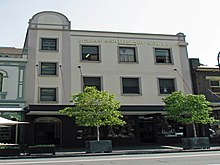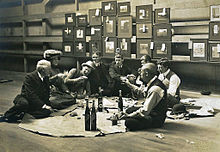Julian Ashton

Julian Rossi Ashton OBE (born January 27, 1851 in Addlestone , Surrey , † April 27, 1942 in Bondi (Sydney) , New South Wales ) was an Australian portrait and landscape painter and founder and director of the influential Julian Ashton Art School .
Life
Ashton was the eldest son of the wealthy American Thomas Briggs Ashton and his wife Henrietta, daughter of Count Carlo Rossi, a Sardinian diplomat. Soon after Julian's birth, the family moved to Gulval near Penzance in Cornwall . His father, an amateur painter, promoted the artistic talent of Julians and his brother George. Around 1862 the Ashton moved to Totnes in Devon , where Ashton attended the local grammar school. After the father's death, the family ran into financial difficulties and moved to London . Ashton took art lessons from an old friend of his father's. At the age of 15 he found a job in the civil engineering department of the Great Eastern Railway and attended evening classes at the West London School of Art . Three years later he worked as a draftsman in a hardware store, which he soon left and worked as an illustrator for magazines such as Chatterbox and Cassell's Magazine . In 1873 he spent a few months at the Académie Julian in Paris . He then worked again as an illustrator in London, where he submitted his work to the Royal Academy of Arts . He married Eliza Ann Pugh († 1900) on August 1, 1876 in the London Borough of Hackney .
In 1878 David Syme , owner of The Age newspaper from Melbourne , stayed in London and hired Ashton as an illustrator. Ashton arrived in Melbourne on June 18, 1878 with his wife and son aboard the Cuzco ship and began working for the Illustrated Australian News . In 1881 he moved to the city-based magazine Australasian Sketcher with Pen and Pencil . A series of pictures was taken in Melbourne showing the final battle of the gang of Australian national hero Ned Kelly in Glenrowan. As Ashton did not feel comfortable in Melbourne, he moved to Sydney in 1883 and accepted the offer to travel extensively to Australia until 1886 for the illustration of the Picturesque Atlas of Australia . During this time he also made drawings for the publication Bulletin .
In 1886 Ashton began teaching privately. In 1887 he set up a studio in Pitt Street, Sydney, where he painted a portrait of the poet and politician Henry Parkes . In the years 1892 1895 he led courses at the Art Society of New South Wales , of which he was president from 1887 to 1892. In 1895 Ashton joined a new trade association, the Society of Artists in Sydney. He had been released from teaching and founded his own school on King Street , which he moved to the Queen Victoria Markets in 1906 and renamed the Sydney Art School . In 1935 he moved the school, now called Julian Ashton Art School , to George Street . The establishment enjoyed a considerable reputation; Her students included George Washington Lambert , Elioth Gruner , Jesse Hilder , Thea Proctor , Sydney Ure Smith , William Dobell , Jean Bellette , Charles Lloyd Jones, and John Richard Passmore .
Ashton was the curator of the Art Gallery of New South Wales in 1889 and 1899 . In that capacity, he bought a painting for the gallery entitled Still Glides the Stream and Shall Forever Glide by painter Arthur Ernest Streeton for £ 70 in 1890 . In the Parliament of New South Wales voices were raised to the number of his own paintings that were purchased by the curators, but Ashton had played no role in their selection. In 1898 he organized the exhibition of Australian art at London's Grafton Gallery . He used his influence on the politicians Henry Parkes and Bernhard Ringrose Wise as well as on the patron Howard Hinton to promote the painters Jesse Hilder, Norman Lindsay and the Australian Impressionists .
In 1897 and 1898, Ashton held the office of President of the Society of Artists , which in 1903 merged with the Art Society of New South Wales to form the Royal Art Society of New South Wales . In 1907 he reestablished the Society of Artist and was its President until 1921 and then its Vice President until 1940 when the institution returned to the Royal Art Society .
In 1892 Ashton was commissioned by lottery entrepreneur George Adams to decorate the Marble Bar in his hotel in Sydney. Ashton was the initiator of the gallery and affiliate retail outlet of the Fine Arts Society on Bligh Street , which was founded in 1911 and was the first such establishment exclusively to focus on Australian art. He also lectured and wrote essays on Australian art.
The established artist produced oil paintings and watercolors. He claimed to have created Australia's first open-air painting with his work Evening, Merri Creek from 1882 . His early landscapes showed a distinctly Australian sense of light and space. He was known for his romantic figure paintings , many of which were taken on the beaches near his home in Bondi. He painted portraits of Henry Parkes and Archbishop Michael Kelly, among others . Around 1914 his eyesight deteriorated, which initially led to color blindness with a weakness for the colors yellow and blue and later severely restricted his peripheral vision . In connection with his lifelong asthma affliction , he was forced to retreat in his activities.
In 1924 Ashton received the Society of Artists Medal for Outstanding Services to Australian Art, in 1930 he was awarded the Commander of the Order of the British Empire and in 1938 the Sydney Sesquicentenary Prize for a watercolor. He published his memoirs in 1941 under the title Now Came Still Evening On .
Julian Ashton died after a long illness at the age of 91 in Bondi, Sydney. He had been teaching his students until shortly before his death. His cremation took place in the Northern Suburbs Crematorium according to the Anglican rite. He left two of his four sons and a daughter from his first marriage and his second wife Constance Irene, née Morley, whom he married on September 8, 1902.
Works (selection)
literature
- The Julian Ashton Book , Sydney 1920
- K. Campbell: Julian Rossi Ashton ... as Art Politician . BA Hons thesis, University of Adelaide, Adelaide 1974.
Web links
Individual evidence
- ↑ a b c d e f g h Katherine Harper: Ashton, Julian Rossi (1851–1942). In: Australian Dictionary of Biography (Volume 7), National Center of Biography, Australian National University , Canberra 1979.
- ↑ a b c d Julian Ashton Was Artists' Guide & Friend. In: The Courier-Mail (Brisbane), April 29, 1942, p. 4.
- ↑ Mr. Julian Ashton. In: The Sydney Morning Herald, January 27, 1931, p. 10.
- ↑ Mr. Julian Ashton Dead. In: Newcastle Morning Herald and Miners' Advocate, April 29, 1942, p. 3.
- ↑ Julian Ashton dead. In: Tweed Daily (Murwillumbah), April 29, 1942, p. 2.
- ^ Funeral Of Julian Ashton. In: The Sun (Sydney), April 29, 1942, p. 5.
| personal data | |
|---|---|
| SURNAME | Ashton, Julian |
| ALTERNATIVE NAMES | Ashton, Julian Rossi (maiden name) |
| BRIEF DESCRIPTION | Australian portrait and landscape painter, founder of the Julian Ashton Art School |
| DATE OF BIRTH | January 27, 1851 |
| PLACE OF BIRTH | Addlestone , Surrey |
| DATE OF DEATH | April 27, 1942 |
| Place of death | Bondi (Sydney) , New South Wales |










